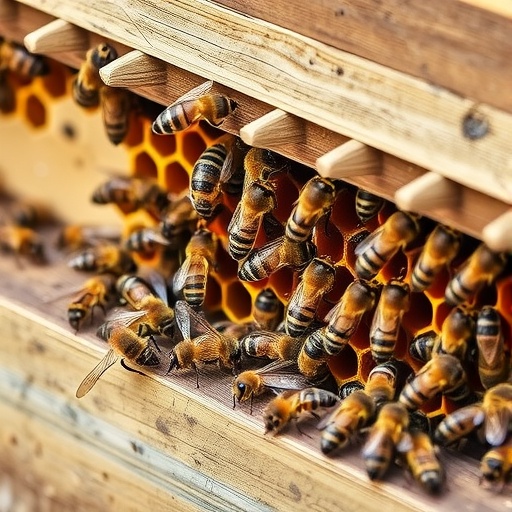In a groundbreaking study published on August 26, 2023, in the esteemed journal PLOS Biology, researchers from the University of Colorado Boulder have revealed the remarkable adaptability of honeybees in constructing their hives. This research, spearheaded by Golnar Gharooni-Fard and her colleagues, emphasizes the dynamic nature of hive building, showcasing how these industrious insects can modify their construction techniques based on the varying conditions of their environment.
Honeybees are often celebrated for their elaborate hives, which serve as vital habitats where they not only store food but also nurture their larvae. The hive-building process is a quintessential example of collective behavior, where thousands of worker bees collaborate to create a complex structure. The study delves into how honeybees exhibit extraordinary flexibility and an innate ability to adjust their honeycomb architecture in response to the size of the foundations provided to them.
At the heart of this investigation was an innovative design: the researchers presented honeybee colonies with sets of 3D-printed plastic honeycomb foundations that varied in size. This unprecedented experimental setup allowed scientists to closely observe the methodologies bees employ when faced with constraints. By utilizing X-ray microscopy, the researchers were able to visualize the construction processes in real-time, providing a comprehensive understanding of the strategies the bees used.
The findings were nothing short of fascinating. When the size of the foundation honeycomb was inadequate for their needs, honeybees displayed remarkable problem-solving skills by merging multiple cells to create larger, usable spaces. This behavior was indicative of their ability to adapt their building strategies to overcome challenges imposed by the dimensions of the foundations. Conversely, when the foundation cells were oversized, the bees ingeniously adjusted their construction technique by building slanted borders to effectively reduce the opening size of each cell, while still maintaining sufficient depth for storage.
An even more striking observation was made when the foundations were excessively large. In these instances, the honeybees took an innovative approach by constructing a new layer of standard-sized honeycombs on top of the larger foundation, utilizing the edges of the plastic structure for support. This layered technique not only highlights the bees’ flexibility but also underscores their ability to execute complex building strategies that allow them to thrive in less-than-ideal conditions.
The implications of this study transcend basic biological understanding; they pave the way for bio-inspired engineering solutions. By examining how honeybees interact with and adapt to their environment, researchers are beginning to construct frameworks that could inform the design of more efficient and adaptable human-made structures. The parallels between the bees’ adaptive strategies and patterns found in other natural phenomena, such as crack formations in drying mud or arrangements seen in atomic crystals, further deepen the significance of this research.
In his insights, corresponding author Francisco López Jiménez emphasized the significance of the findings. He noted that the bees, when presented with a pre-defined hexagonal pattern that diverged from their preferred dimensions, employed at least three distinct techniques to mold those structures into something more conducive to their needs. This adaptability illustrates the sophistication of their building processes and their deep understanding of the physical principles at play.
Co-corresponding author Orit Peleg added to this perspective, remarking on the bees’ intuitive grasp of collective construction physics. The research team is only beginning to unravel the rich tapestry of strategies invoked by these tiny builders, which include not just merging and tilting their constructions but also layering them in ways that maximize utility and efficiency.
As many of us may look at honeycombs as simple hexagonal structures, this study reveals the complexity hidden beneath the surface. The adaptability of honeybees in their hive-building process challenges our perceptions of animal intelligence and the innate problem-solving capabilities found within the natural world. The strategies employed by these diligent workers mirror advanced engineering practices, and their instinctual understanding of spatial relationships speaks volumes about the cognitive abilities of social insects.
As we delve deeper into the world of collective behavior exhibited by honeybees, we find echoes of these strategies in other ecosystems. The patterns seen in honeycomb construction resonate with various complex systems across scientific disciplines, hinting at universal principles of adaptability and resourcefulness that govern both the natural world and engineered systems.
López Jiménez concluded with a thought-provoking observation: the strategies bees employ when confronted with unusual geometries reflect patterns observed in completely different systems. This revelation hints at the interconnectedness of various scientific fields, bridging the gap between biology, materials science, and environmental design. Understanding these correlations could inspire revolutionary technologies that learn from nature’s ingeniously adaptive systems.
In conclusion, the research conducted by Gharooni-Fard and her team stands at the nexus of biology and engineering, unlocking insights that reveal the impressive capabilities of honeybees. As we continue to explore the dimensions of their hive-building strategies, we gain not only a deeper appreciation for these essential pollinators but also valuable lessons that could reshape our approaches to building and design in our own turbulent modern world.
This provocative study not only broadens our understanding of honeybee behavior but also illustrates the profound connections between biological phenomena and innovative engineering principles. It stands as a testament to the wonders of natural engineering, where adaptability and collaboration weave intricate solutions in even the most challenging environments.
Subject of Research: Honeybee hive construction strategies.
Article Title: Honeybees adapt to a range of comb cell sizes by merging, tilting, and layering their construction.
News Publication Date: August 26, 2023.
Web References: PLOS Biology
References: Gharooni-Fard G, Kavaraganahalli Prasanna C, Peleg O, López Jiménez F (2025) Honeybees adapt to a range of comb cell sizes by merging, tilting, and layering their construction. PLoS Biol 23(8): e3003253.
Image Credits: Golnar Gharooni-Fard (CC-BY 4.0)
Keywords
Adaptability, honeybee, hive construction, bio-inspired design, collective behavior, 3D printing, architectural strategies, environmental adaptation.




